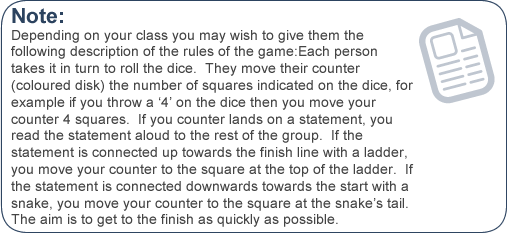Lesson 10: Snakes and Ladders
Introduction

Time:
- Single class period
Materials:
Activity 2: Snakes and Ladders
- Dice
- Counters
- Student Worksheet: Snakes and Ladders
Introduction:
This lesson gives students an opportunity to revise and reflect on their learning about consumer rights and how to protect themselves when buying goods and services in shops or online.
Step-By-Step Instructions

Activity 1: Review of Lesson Nine Homework Task
- Ask students to create a gallery of their advertisements warning people about scams (Lesson 9: Homework Task).
- Invite students to look carefully at each of the ads about scams and choose the three they think are the most effective in terms of images or captions.
- Invite a selection of students to discuss their top three ads, giving reasons why these are the most effective warnings against scams.
- Ask the class if everyone is familiar with the board game Snakes and Ladders?
 Depending on your class you may wish to give them the following description of the rules of the game: Each person takes it in turn to roll the dice. They move their counter (couloured disk) the number of squares indicated on the dice, for example if you throw a ‘4’ on the dice then you move your counter 4 squares. If you counter lands on a statement, you read the statement aloud to the rest of the group. If the statement is connected up towards the finish line with a ladder. You move your counter to the square at the top of the ladder. If the statement is connected downwards towards the start with a sname, you move your counter to the square at the snake’s tail. The aim is to get to the finish as quickly as possible.
Depending on your class you may wish to give them the following description of the rules of the game: Each person takes it in turn to roll the dice. They move their counter (couloured disk) the number of squares indicated on the dice, for example if you throw a ‘4’ on the dice then you move your counter 4 squares. If you counter lands on a statement, you read the statement aloud to the rest of the group. If the statement is connected up towards the finish line with a ladder. You move your counter to the square at the top of the ladder. If the statement is connected downwards towards the start with a sname, you move your counter to the square at the snake’s tail. The aim is to get to the finish as quickly as possible. - Read the following statements aloud to the class, asking them whether they think each statement would be connected to a snake (a downwards, negative move) and (an upwards, positive move) in a game of Snakes and Ladders:
- You look up information on consumer rights on www.ccpc.ie/consumers. LADDER
- A new clothes shop opens up in town. You buy new jeans but throw away your proof of purchase straight away. SNAKE
- When you shop online you always try to buy from an EU-based company to make sure that you are covered by EU consumer legislation. LADDER
- You buy a new smart phone but it doesn’t work properly. You bring it back to the shop and accept when they say that you have to pay for the repairs yourself. SNAKE
- Your family get a new dog and you persuade your mother to look into pet insurance. LADDER
- You buy a concert ticket online and then decide that you don’t want to go but you forgot that the cooling-off period doesn’t apply to things like concert tickets. SNAKE
- Your phone bill is huge – you’re being charged for calls you did not make. There is obviously some kind of mistake. You completely lose the plot with the company representative on the phone. SNAKE
- You learn about scams in school and you now know how to avoid becoming a victim of a scam. LADDER
- Divide the class into small groups.
- Distribute one dice, the appropriate number of counters and Student Worksheet: Snakes and Ladders to each group.
- Circulate around the room checking that each group is playing the game correctly.
- Once several students in each group have reached the finish, invite students to identify which of the statements on their worksheet represents the behaviour/actions of an informed consumer and which represent the behaviours/actions of someone who is not informed.
- Ask each group to pick a statement representing the behaviour/action of an informed consumer from Student Worksheet: Snakes and Ladders, and finish the following sentences in relation to their chosen statement:
……………….is an example of a the behaviour/action of an informed consumer because…………
- Conclude by highlighting that Snakes and Ladders could be said to reflect real life insofar as people make both positive and negative decisions, but to remember that it is never too late to start afresh and get informed about your consumer rights.



